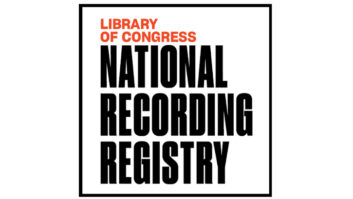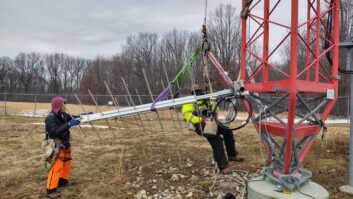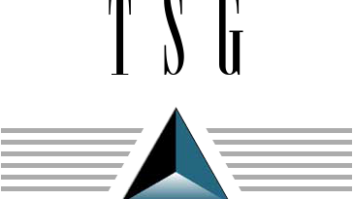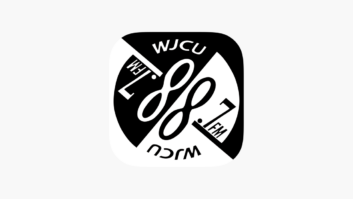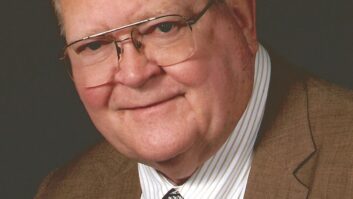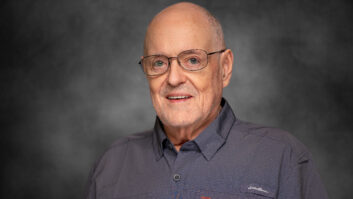Hello Cleveland!
Aug 1, 2003 12:00 PM, By John Grayson
Equipment ListBroadcasters General Store – dealer, organizer
AKG 240M headphones
Auralex Acoustic treatment
CBT on-air light
Comrex Matrix codec
Denon DN-C635 CD/MP3
Dorrough 40-A2
Enco Systems DADpro32
Eventide BD500-010
Gepco cable (5596M, D61801EZ, GA61804GFC, RGBSC260TS-5)
Hafler P3000 and P1000
Henry Patchbox, Superelay
JBL Control 1
Liebert GxT2-1500RT120 UPS
Logitek Audio Numix
LPB Silent Mic Boom
Mackie 1604
Marantz PMD510 cassette
Middle Atlantic drawers and panels
Neutrik NC3FP1B, NC3FXB, NC3MXB, NP2C, and NP3COmnimount 30.0WB speaker mounts
Radio Systems CT2002 clock, pushbutton panels
Rane HC6 headphone amp
Rane VP12 voice processor
RDL STPH1 phono preamp
SBS MatchIt interface
Shure SM7b mic
Shure U2/Beta87 wireless mic
Shure P7T/P7R in-ear monitors
SKB rack
Studio Technology furniture
Tannoy System 800
Tascam CD-RW2000
Tascam MD-301MKII
Technics SL1200MKII turntable
Telos desktop director
Telos Zephyr Xstream
Telos Twox12
Ward-Beck POD6B headphone amp
Whirlwind mic cable
Since opening its doors in 1995, radio stations around the worldhave been drawn to the Rock and Roll Hall of Fame and Museum’s radiostudio as a location for originating remote broadcasts. It’s hard notto feel the excitement of the Rock Hall when you’re physically there,but for the visiting stations, delivering that intensity to theirlisteners was always somewhat challenging, due in large part to theoriginal studio’s design.
That has all changed, however, with the recently completed redesignof the newly named Alan Freed Radio Studio, allowing visiting stationsto broadcast while feeling a part of the Rock Hall and conveying a “youare there” experience.
Alan Freed was a pioneering disk jockey who began his notoriety inthe Cleveland area. He is often credited with coining the term “rockand roll.”
Photo by Louis Anderson. Courtesy of the Convention and Visitors Bureauof Greater Cleveland.

Courtesy of the Rock andRoll Hall of Fame and Museum.

Looking into the radiostudio from the fifth floor landing.

Welcome to the Alan FreedRadio Studio.

Looking out the window tothe fifth floor landing.

The studio layout has sixmic positions. The museum hall is visible through the glass behind theoperator.

The fully-equipped studionow provides the versatility to handle any on-air need.

The original studio was built in the early 90s, which was a fairlydubious period to be buying radio equipment, because at the timedigital standards were just coming to the forefront. Also, becausethere had never before been a Rock Hall, the original designers weren’tquite sure how the radio studio was supposed to function. In one sense,it was almost as if someone had selected equipment at random from acatalog to build the room. As a result, the original studio was lessthan functional.
In the ensuing years, as the Rock Hall staff learned more about thehardware and the technology necessary to effectively carry out liveradio programming, the radio studio evolved into its present form: aremote location capable of meeting the needs of any visiting radiostation or artist.
The redesign was a cooperative effort between the technical staff atthe Rock Hall and Broadcasters General Store, which specified andinstalled the equipment, all donated from manufacturers throughout thebroadcast industry.
The design goals for the new studio included upgrading thetechnology to current-day standards; equipping the studio withappropriate recording, edit, storage and playback equipment that itdidn’t have in the past; and equipping it with a sufficient quantity ofappropriate microphones and mixing equipment to support visitingremotes as well as impromptu live performances.
A temporary home
Some tourist attractions will invite a radio station to broadcastlive from the venue and then provide a folding table somewhere near thefront door with a telephone jack.
At the Rock Hall, the goal is to put the visiting stations in anenvironment in which they’re comfortable. What’s more, the fifth-floorradio studio is also actually a working exhibit. Located behind adouble-glass wall, visitors can look in, see what’s going on and, onoccasion, listen to the broadcasts. The Alan Freed Radio Studio is madeavailable at no charge to visiting broadcasters from around the worldthat want to come to the Rock Hall and broadcast live.
Not only do visiting stations benefit from the panache oforiginating a distinctive remote broadcast from the Rock Hall, theyalso feel as though they are a part of the exhibit, which adds value totheir visit.
These are all benefits of the new studio’s design, and the changesare evident from the smallest detail, starting with the furniture andlayout of the room. Many stations will bring listeners or contestwinners with them for a remote, and while there’s no audience sectionin the studio, there are five guest positions opposite the console. Thestudio can comfortably hold 10 people.
The studio is set up for spoken word principally, however, withsufficient advance notice the studio can be configured to host live,small-scale musical performances.
That’s quite different from the original studio, where if an artistwanted to bring instruments for a live set, it was often like athree-act play to mic the studio for the performance. The previouslyinstalled equipment was just not right for that task. In the newstudio, everything is in place.
For example, the studio is now outfitted with more than one codec,including two Telos Systems Zephyr Xstream codecs and a Comrex Matrixcodec. This provides the ability to go from point to multi-point, aswell as to schedule shows back to back. When more than one station isvisiting, one can connect through Zephyr #1 and another on Zephyr #2.At the top of the hour, the players switch places and go. In the oldstudio with just one codec, it was a challenge to change shifts. It’salmost seamless now, with shifts changing in two minutes instead of10.
The studio is outfitted with ISDN and POTS codecs, which providegreater flexibility for visiting stations. Because it is never knownwhat kind of equipment will exist at the far end, the goal was to haveenough interface equipment at the Rock Hall so stations won’t need tobring any hardware with them. They can just plug in and sit down.
The improved codec capacity also facilitates interviews withmusicians located off-site in their personal studios, or if artistswant to use the studio for live interviews with stations around thecountry, to promote a new album or tour, for example.
Step inside
The approximate room size of 300-square-feet stayed the same duringthe redesign, and the only original products kept were turntables.Other than that, everything is brand new.
The key to any studio is building an environment that is conduciveto creativity, comfort and workflow, and that starts with thefurniture. Provided by Studio Technology, the furniture wascustom-designed to suit the studio’s more contemporary needs.
The furniture was elevated to stand-up height and the new furniturealso has more rack space, allowing it to hold more equipment. Theorientation of the furniture was also changed so the board operatordoes not have his back to the glass wall, ultimately contributing to amore user-friendly workflow.
At the center of the studio is a Logitek Audio Numix digitalconsole, chosen for its ability to handle multiple types of signals.One challenging aspect of the redesign was that the new studio neededto be able to accommodate a wide variety of formats. If visitingstations were only going to talk, there wouldn’t be a need for much ofthe equipment that is currently installed. But different stations comewith different expectations and different needs, so the studio had tohave a console that offered significant input and outputversatility.
For example, every radio station has a need for a mix-minus feed,and this console allows operators to give stations what they want withthe push of a couple of buttons.
Perhaps the real heart of the studio is the Enco Systems DADpro32digital audio storage, editing and play-out system, which provides theRock Hall staff and visiting stations with a simple and flexibleplatform, especially if the stations have a different type of storagesystem back at their home studios.
Connecting all this equipment together is a variety of cable fromGepco, which worked with Broadcasters General Store and Logitek todetermine pin-outs and cable lengths to produce prewired cables. Thiscreated significant time saving for the project because the engineerswere able to take the cables out of the boxes, attach them and within amatter of hours have the entire facility wired and running.
Gepco supplied 100-feet of cable, including the 5596M digital audiomicrophone cable; D61801EZ dual pair analog audio cable; GA61804GFC4-pair, 22-gage, analog audio multi pair cable; and RGBSC260TS-5conductor plenum coax.
Neutrik contributed a variety of cable connectors, phone plugs andreceptacles, including its models NC3FP1B, NC3FXB, NC3MXB, NP2C andNP3C.
One of the objectives was that visiting stations or artists wouldnever have to open a rack to accommodate a broadcast, because thestudio would be populated with any type of equipment that could beneeded.
The studio is in the process of creating an I/0 panel that will beinstalled near the console to accommodate any special needs, such as anMP3 player or keyboard. There is also a wireless microphone system anda microphone outside the studio’s glass wall, so the on-air teams andspectators can talk back and forth. There’s also Shure wirelessequipment for the announcers so they can go outside the studio and walkaround the museum, and they can use a wireless IFB to hear what’s goingon in the studio.
The new Alan Freed Radio Studio at Cleveland’s Rock and Roll Hall ofFame and Museum provides a showcase facility for visiting stations thatnot only looks good, but provides exceptional flexibility for the needsof the various visiting stations.
Grayson is corporate donor relations manager for the Rock andRoll Hall of Fame and Museum.





